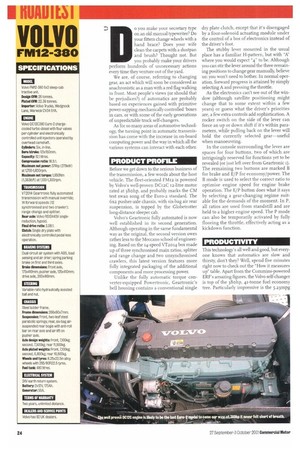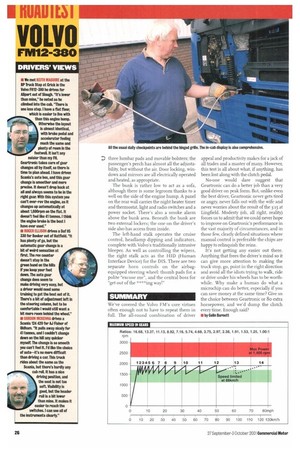o you make your secretary type on an old manual
Page 24

Page 25

Page 26

If you've noticed an error in this article please click here to report it so we can fix it.
typewriter? Do your fitters change wheels with a hand brace? Does your wife clean the carpets with a dustpan and brush? Thought not. But you probably make your drivers perform hundreds of unnecessary actions every time they venture out of the yard.
We are, of course, referring to changing gear, an act which will soon be considered as anachronistic as a man with a red flag walking in front. Most people's views (or should that be prejudices?) of automatics are probably based on experiences gained with primitive power-sapping mechanically controlled 'boxes in cars, or with some of the early generations of unpredictable truck self-changers.
As for so many areas of automotive technology, the turning point in automatic transmission has come with the increase in on-board computing power and the way in which all the various systems can interact with each other.
PRODUCT PROFILE
Before we get down to the serious business of the transmission, a few words about the host vehicle. The fleet-oriented FM r2 is powered by Volvo's well-proven DCr2C 12-litre motor rated at 38ohp, and probably marks the CM test swan song of the Euro-2 standard. The Gx2 pusher-axle chassis, with six-bag air rear suspension, is topped by the Globetrotter long-distance sleeper cab.
Volvo's Geartronic fully automated is now well established in its second generation. Although operating in the same fundamental way as the original, the second version owes rather less to the Meccano school of engineering. Based on the 14-speed VT2014 box made up of three synchronised main ratios, splitter and range change and two unsynchronised crawlers, this latest version features more fully integrated packaging of the additional components and more processing power.
Unlike the fully automatic torque converter-equipped Power tronic, Geartronic's bell housing contains a conventional single dry plate clutch, except that it's disengaged by a four-solenoid actuating module under the control of a box of electronics instead of the driver's foot.
The stubby lever mounted in the usual place has a familiar H-pattern, but with "A'.' where you would expect "4" to be. Although you can stir the lever around the three remaining positions to change gear manually, believe us: you won't need to bother, In normal operation, forward progress is attained by simply selecting A and pressing the throttle.
As the electronics can't see out of the window (although satellite positioning might change that to some extent within a few years) or guess what the driver's priorities are, a few extra controls add sophistication. A rocker switch on the side of the lever can force an up or down shift if it's within parameters, while pulling back on the lever will hold the currently selected gear—useful when manoeuvring.
In the console surrounding the lever are spaces for four buttons, two of which are intriguingly reserved for functions yet to be revealed (or just left over from Geartronic r). The remaining two buttons are marked B for brake and E/P for economy/power. The B mode is used to select the correct ratio to optimise engine speed for engine brake operation. The Fp) button does what it says by selecting a gear-changing regime suitable for the demands of the moment. In P, all ratios are used from standstill and are held to a higher engine speed. The P mode can also be temporarily activated by fully flooring the throttle, effectively acting as a kickdown function,
PRODUCTIVITY
This technology's all well and good, but everyone knows that automatics are slow and thirsty, don't they? Well, spend five minutes right now to check out the "How it measures up" table. Apart from the Cummins-powered ERF's amazing figures, the Volvo self-changer is top of the 38ohp, 41-tonne fuel economy tree. Particularly impressive is the 5.23mpg we recorded on the toughest stretch of the route, the A68 from St Boswells to Nevilles Cross. The Geartronic lived up to its claim to be in the right gear all the time, never failing to produce perfect shifts even on the worst of the killer climbs.
And the Volvo didn't obtain those figures by pussy-footing around, either. The 74,3km/h overall average speed for the route is not only quicker than anything below 4 oohp, it's in there with the best averages for trucks with up to 200hp more.
So much for comparing it with the opposition: what you really want to know is how it matches a manual Volvo 380. Well we can't tell you that because we haven't tested one at 41 tonnes, but in 1998 we did drive an FM.12...80 4x2 with a low-roof cab at 38 tonnes. Headline figures for that one, with considerably less work to do, were 8.33mpg and 7o.9km/h, indicating that there is little if any difference. Kerbweightwise, the EMI2 could shed a few pounds but still delivers more than 26 tonnes at the 41-tonne mark.
Obviously you'd expect all this technology to come at price, and you wouldn't be wrong. Geartronic adds L2,500 to the front-end cost of an PM-t2 with a VT2014 box; but the good news is that Volvo says the maintenance contract price is the same regardless of whether you have a clutch or not.
ON THE ROAD
Although the cab interior was never silent, it was quiet enough so that during a brief shower the loudest noise was the rain hitting the windscreen. The only exception was when the cooling Fan cut in while descending the English side of Carter Bar—it sounded like we'd run over a helicopter.
Just to satisfy a few inner suspidons, we carried out our standingstart o-Sokm/h acceleration testing in both E and P modes. The surprising result was a time more than a second quicker in Economy mode than in Performance. The extra time taken to visit every gear more than offset any benefit from the changed shift points. On the road, the ease of using the throttle "kick-down" facility means the P button is largely redundant, although the detent on the throttle pedal could do with being stronger in order to prevent its inadvertent activation.
On various occasions during the test we tried to improve on Geartronic's decisions by using the switch on the gear lever to force changes, but almost without exception the electronics beat us to it by the time we'd decided to go for it, so we gave up in the end.
The electronics can work out whether the truck is going up or downhill and modify its behaviour accordingly, so apart from pressing the H button occasionally and using H to aid manoeuvring or to hang on for the crest of a hill, there's little point in any manual intervention at all. Even running at 41 tonnes the 380 was never seriously in need of any more power, as the journey times prove. The proving ground hill start was easy on the i-in-s slope, and gave the impression that it would handle much tougher gradients, but a problem with the trailer's under-run bar grounding on the test hill approach meant we couldn't actually prove it.
An excellent secondary braking setup consists of an exhaust brake first stage followed by the powerful VEB (Volvo Engine Brake). Combined with H mode, VEB allowed us to complete the hilly run down from Kinross Services to the Forth Bridge without touching the service brakes. The all-drum braking system worked perfectly well on the rare occasions it was needed. Cruise control continues to work throughout gear changes, with the engine brake beginning to operate automatically at 7km/11 over the set cruise speed.
One point to remember is that cruise won't work at all until the brakes have been applied for about four seconds. The ride was always comfortable but controlled, while the steering of the pusher chassis, though never quite as precise as a twin-steer, gave us no grounds for complaint.
CAB COMFORT
Climbing aboard this truck gave us an incongruous feeling, caused by the mix of fleet FM and inter-galactic Globetrotter. The navel. height floor means the cab interior is not overblessed with space but it's an acceptable compromise. The main benefit is tile easy access given by the two steps, wide door and wellplaced grab handles.
The wrap-round dash is dominated by the binnacle housing the retractable Dynafleet screen; its control unit is mounted just above the Volvo RDS EON radio-cassette unit. The instrument panel has lots of dials to look at, with the usual essentials complemented by gauges for turbo boost and rear suspension pressure. The display for the DES (Driver Information System) is located between the rev counter and the pop-up integral tachograph.
The most urgently needed switches, for axle lift, diff-lock and engine brake, are mounted within easy reach of the driver's left hand, while the work light switch can be reached from outside. Heater controls are straightforward sliders, with a rotary blower switch and the usual (for us) untouchable air-con switch. A phone mounting panel is included as part of the central cupholder moulding.
Above the screen, the upper header section has two elasticated pockets and a largish locker, while the lower portion houses the audio speakers, two lockers on the left side, a spare audio housing and minor switches, including an item not previously seen—a panic button linked by GSM to Volvo's support centre.
The green/grey cloth-trimmed driver's airsuspended and heated seat has all the electric adjustability anyone could need, including three lumbar pads and movable bolsters; the passenger's perch has almost all the adjustability, but without the air. Door locking, windows and mirrors are all electrically operated and heated, as appropriate.
The bunk is rather low to act as a sofa, although there is some legroom thanks to a well on the side of the engine hump. A panel on the rear wall carries the night heater timer and thermostat, light and radio switches and a power socket. There's also a smoke alarm above the bunk area. Beneath the bunk are two external lockers; the one on the driver's side also has access from inside.
The left-hand stalk operates the cruise control, headlamp dipping and indicators, complete with Volvo's traditionally intrusive bleeper. As well as controlling the wipers, the right stalk acts as the HID (Human Interface Device) for the ID IS. There are two separate horn controls on the airbagequipped steering wheel: thumb pads for a polite "excuse me", and the central boss for "get out of the ****ing way!"
appeal and productivity makes for a jack of all trades and a master of many. However, this test is all about what, if anything, has been lost along with the clutch pedal.
No-one would dare suggest that Geartronic can do a better job than a very good driver on peak form. But, unlike even the best driver, Geartronic never gets tired or angry, never falls out with the wife and never worries about the result of the 3:15 at Lingfield. Modesty (oh, all right, reality) forces us to admit that we could never hope to improve on Geartronic's performance in the vast majority of circumstances, and in those few, clearly defined situations where manual control is preferable the chips are happy to relinquish the reins.
It's not getting any easier out there. Anything that frees the driver's mind so it can give more attention to making the truck stop, go, point in the right direction and avoid all the idiots trying to walk, ride or drive under his wheels has to be worthwhile. Why make a human do what a microchip can do better, especially if you can save money at the same time? Give us the choice between Geartronic or 8o extra horsepower, and we'd dump the clutch every time. Enough said?




































































































































